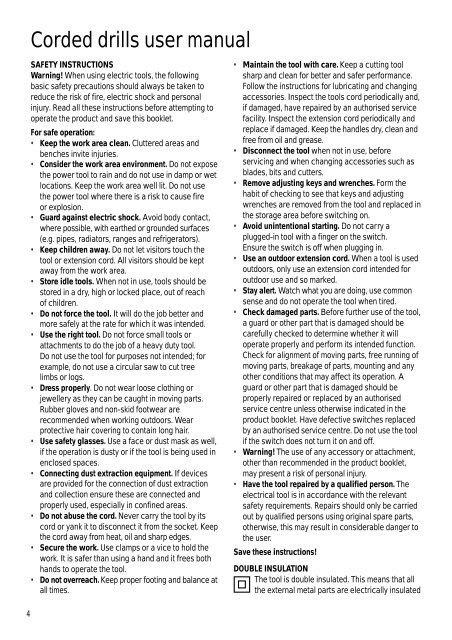BlackandDecker Perceuse- Kd352 - Type 1 - Instruction Manual
BlackandDecker Perceuse- Kd352 - Type 1 - Instruction Manual
BlackandDecker Perceuse- Kd352 - Type 1 - Instruction Manual
You also want an ePaper? Increase the reach of your titles
YUMPU automatically turns print PDFs into web optimized ePapers that Google loves.
Corded drills user manual<br />
SAFETY INSTRUCTIONS<br />
Warning! When using electric tools, the following<br />
basic safety precautions should always be taken to<br />
reduce the risk of fire, electric shock and personal<br />
injury. Read all these instructions before attempting to<br />
operate the product and save this booklet.<br />
For safe operation:<br />
• Keep the work area clean. Cluttered areas and<br />
benches invite injuries.<br />
• Consider the work area environment. Do not expose<br />
the power tool to rain and do not use in damp or wet<br />
locations. Keep the work area well lit. Do not use<br />
the power tool where there is a risk to cause fire<br />
or explosion.<br />
• Guard against electric shock. Avoid body contact,<br />
where possible, with earthed or grounded surfaces<br />
(e.g. pipes, radiators, ranges and refrigerators).<br />
• Keep children away. Do not let visitors touch the<br />
tool or extension cord. All visitors should be kept<br />
away from the work area.<br />
• Store idle tools. When not in use, tools should be<br />
stored in a dry, high or locked place, out of reach<br />
of children.<br />
• Do not force the tool. It will do the job better and<br />
more safely at the rate for which it was intended.<br />
• Use the right tool. Do not force small tools or<br />
attachments to do the job of a heavy duty tool.<br />
Do not use the tool for purposes not intended; for<br />
example, do not use a circular saw to cut tree<br />
limbs or logs.<br />
• Dress properly. Do not wear loose clothing or<br />
jewellery as they can be caught in moving parts.<br />
Rubber gloves and non-skid footwear are<br />
recommended when working outdoors. Wear<br />
protective hair covering to contain long hair.<br />
• Use safety glasses. Use a face or dust mask as well,<br />
if the operation is dusty or if the tool is being used in<br />
enclosed spaces.<br />
• Connecting dust extraction equipment. If devices<br />
are provided for the connection of dust extraction<br />
and collection ensure these are connected and<br />
properly used, especially in confined areas.<br />
• Do not abuse the cord. Never carry the tool by its<br />
cord or yank it to disconnect it from the socket. Keep<br />
the cord away from heat, oil and sharp edges.<br />
• Secure the work. Use clamps or a vice to hold the<br />
work. It is safer than using a hand and it frees both<br />
hands to operate the tool.<br />
• Do not overreach. Keep proper footing and balance at<br />
all times.<br />
• Maintain the tool with care. Keep a cutting tool<br />
sharp and clean for better and safer performance.<br />
Follow the instructions for lubricating and changing<br />
accessories. Inspect the tools cord periodically and,<br />
if damaged, have repaired by an authorised service<br />
facility. Inspect the extension cord periodically and<br />
replace if damaged. Keep the handles dry, clean and<br />
free from oil and grease.<br />
• Disconnect the tool when not in use, before<br />
servicing and when changing accessories such as<br />
blades, bits and cutters.<br />
• Remove adjusting keys and wrenches. Form the<br />
habit of checking to see that keys and adjusting<br />
wrenches are removed from the tool and replaced in<br />
the storage area before switching on.<br />
• Avoid unintentional starting. Do not carry a<br />
plugged-in tool with a finger on the switch.<br />
Ensure the switch is off when plugging in.<br />
• Use an outdoor extension cord. When a tool is used<br />
outdoors, only use an extension cord intended for<br />
outdoor use and so marked.<br />
• Stay alert. Watch what you are doing, use common<br />
sense and do not operate the tool when tired.<br />
• Check damaged parts. Before further use of the tool,<br />
a guard or other part that is damaged should be<br />
carefully checked to determine whether it will<br />
operate properly and perform its intended function.<br />
Check for alignment of moving parts, free running of<br />
moving parts, breakage of parts, mounting and any<br />
other conditions that may affect its operation. A<br />
guard or other part that is damaged should be<br />
properly repaired or replaced by an authorised<br />
service centre unless otherwise indicated in the<br />
product booklet. Have defective switches replaced<br />
by an authorised service centre. Do not use the tool<br />
if the switch does not turn it on and off.<br />
• Warning! The use of any accessory or attachment,<br />
other than recommended in the product booklet,<br />
may present a risk of personal injury.<br />
• Have the tool repaired by a qualified person. The<br />
electrical tool is in accordance with the relevant<br />
safety requirements. Repairs should only be carried<br />
out by qualified persons using original spare parts,<br />
otherwise, this may result in considerable danger to<br />
the user.<br />
Save these instructions!<br />
DOUBLE INSULATION<br />
The tool is double insulated. This means that all<br />
the external metal parts are electrically insulated<br />
4
















